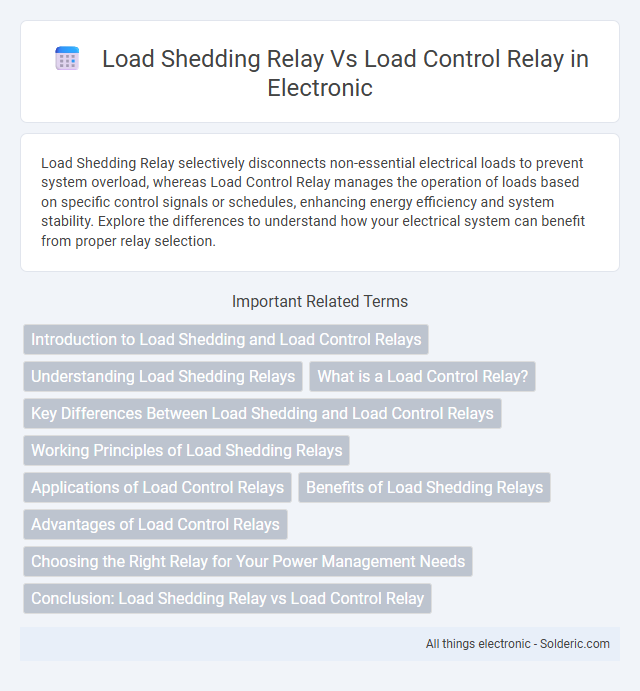Load Shedding Relay selectively disconnects non-essential electrical loads to prevent system overload, whereas Load Control Relay manages the operation of loads based on specific control signals or schedules, enhancing energy efficiency and system stability. Explore the differences to understand how your electrical system can benefit from proper relay selection.
Comparison Table
| Feature | Load Shedding Relay | Load Control Relay |
|---|---|---|
| Primary Function | Automatically disconnects non-essential loads during power shortages | Manually or automatically controls load switching to optimize power usage |
| Operation | Based on system frequency or load demand thresholds | Triggered by control signals or preset schedules |
| Application | Power grid stabilization and demand response management | Energy management and load scheduling in industrial/commercial systems |
| Response Time | Fast, critical for preventing blackouts | Moderate, based on control strategy |
| Load Prioritization | Enforces priority-based load disconnection | Enables programmed load switching sequences |
| Integration | Often integrated with grid protection systems | Integrated with energy management systems (EMS) |
| Examples | Frequency-based relays, under/over frequency relays | Time-based relays, programmable logic relays (PLRs) |
Introduction to Load Shedding and Load Control Relays
Load shedding relays are designed to automatically disconnect non-essential electrical loads during peak demand to prevent system overload and maintain grid stability. Load control relays manage the operation of specific electrical devices by switching them on or off based on preset conditions, optimizing energy consumption. Understanding the differences between these relays helps you implement effective energy management and protect electrical installations from faults or excessive load conditions.
Understanding Load Shedding Relays
Load shedding relays are critical devices designed to prevent power system overloads by automatically disconnecting non-essential loads during peak demand or fault conditions. These relays monitor voltage and frequency levels, ensuring system stability by shedding load to maintain the balance between supply and demand. Unlike load control relays that primarily manage scheduled load operations, load shedding relays respond dynamically to real-time grid stresses to avoid blackouts and equipment damage.
What is a Load Control Relay?
A Load Control Relay is an electrical device designed to manage the switching of electrical loads to optimize power distribution and prevent overloads. It functions by automatically controlling the connection and disconnection of specific electrical circuits based on preset conditions, enhancing energy efficiency and system reliability. Unlike a Load Shedding Relay, which primarily protects the system by shedding loads during power shortages, the Load Control Relay actively manages load operation to maintain stable and balanced power usage.
Key Differences Between Load Shedding and Load Control Relays
Load shedding relays are designed to protect electrical systems by disconnecting non-essential loads during periods of high demand or supply constraints, thus preventing system overload and blackouts. In contrast, load control relays manage and optimize energy consumption by selectively switching loads on or off based on predefined schedules or real-time signals, enhancing operational efficiency and cost savings. The key differences lie in their primary functions--load shedding relays prioritize system stability during faults or peak loads, while load control relays focus on energy management and demand response.
Working Principles of Load Shedding Relays
Load shedding relays operate by continuously monitoring the electrical load and system frequency, automatically disconnecting non-essential loads to prevent grid instability or blackout during peak demand or generation shortfalls. These relays use preset thresholds to trigger load disconnection when system frequency drops below a critical value, ensuring balanced power distribution and protecting equipment from damage. Your power system's reliability depends on the precise and timely activation of load shedding relays to maintain grid stability under stress conditions.
Applications of Load Control Relays
Load control relays are primarily used in building automation systems to manage lighting, heating, ventilation, and air conditioning (HVAC) loads efficiently. These relays enable you to reduce electrical consumption during peak demand periods by selectively switching off non-essential loads, enhancing energy savings and grid stability. Unlike load shedding relays that respond automatically to grid signals, load control relays offer customizable load management for comfort and energy efficiency in residential and commercial environments.
Benefits of Load Shedding Relays
Load Shedding Relays optimize power distribution by automatically disconnecting non-essential loads during peak demand, preventing system overload and reducing the risk of blackouts. Their ability to enhance grid stability and improve energy efficiency ensures reliable operation of critical equipment and reduces operational costs. By integrating load shedding relays, your electrical system gains precise control over load management, safeguarding both infrastructure and performance.
Advantages of Load Control Relays
Load Control Relays offer precise management of electrical loads by enabling selective switching, reducing energy wastage and improving system efficiency compared to traditional Load Shedding Relays. Their ability to automate load distribution enhances the stability of power systems, preventing overloads and minimizing downtime. Your power network benefits from increased reliability and cost savings by integrating Load Control Relays into demand response strategies.
Choosing the Right Relay for Your Power Management Needs
Choosing between a Load Shedding Relay and a Load Control Relay depends on the specific power management requirements of your system. Load Shedding Relays are designed to automatically disconnect non-essential loads during peak demand or fault conditions to prevent system overloads and maintain stability. Load Control Relays, on the other hand, provide manual or automatic control of electrical loads for energy optimization and operational flexibility without necessarily disconnecting them during faults.
Conclusion: Load Shedding Relay vs Load Control Relay
Load Shedding Relays are designed to automatically disconnect non-essential loads during power system disturbances to maintain stability, whereas Load Control Relays primarily manage load switching based on preset conditions for operational efficiency. The key difference lies in their application: load shedding ensures system protection under faults or overloads, while load control optimizes load distribution during normal operations. Selecting between the two depends on the specific power management goals, with load shedding relays crucial for grid reliability and load control relays enhancing energy efficiency.
Load Shedding Relay vs Load Control Relay Infographic

 solderic.com
solderic.com